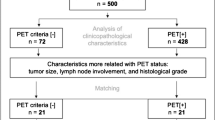Abstract
Introduction
We report the first case of an intraoperative radiotherapy (IORT) in a patient with recurrent glioblastoma multiforme (GBM) who was followed up with a novel magnetic resonance imaging (MRI) method—23Na-MRI—in comparison to a standard contrast-enhanced 1H-MRI and 18F-FET-PET.
Methods
A 56-year-old female patient with diagnosed GBM in July 2012 underwent tumor resection, radiochemotherapy, and three cycles of chemotherapy. After a relapse, 6 months after the initial diagnosis, an IORT was recommended which was performed in March 2013 using the INTRABEAM system (Carl Zeiss Meditec AG, Germany) with a 3-cm applicator and a surface dose of 20 Gy. Early post-operative contrast-enhanced and 1-month follow-up 1H-MRI and a 18F-FET-PET were performed. In addition, an IRB-approved 23Na-MRI was performed on a 3.0-T MR scanner (MAGNETOM TimTrio, Siemens Healthcare, Germany).
Results
After re-surgery and IORT in March 2013, only a faint contrast enhancement but considerable surrounding edema was visible at the medio-posterior resection margins. In April 2013, new and progressive contrast enhancement, edema, 23Na content, and increased uptake in the 18F-FET-PET were visible, indicating tumor recurrence. Increased sodium content within the area of contrast enhancement was found in the 23Na-MRI, but also exceeding this area, very similar to the increased uptake depicted in the 18F-FET-PET. The clearly delineable zone of edema in both examinations exhibits a lower 23Na content compared to areas with suspected proliferating tumor tissue.
Conclusion
23Na-MRI provided similar information in the suspicious area compared to 18F-FET-PET, exceeding conventional 1H-MRI. Still, 23Na-MRI remains an investigational technique, which is worth to be further evaluated.




Similar content being viewed by others
References
Stupp R et al (2005) Radiotherapy plus concomitant and adjuvant temozolomide for glioblastoma. N Engl J Med 352(10):987–996
Park JK et al (2010) Scale to predict survival after surgery for recurrent glioblastoma multiforme. J Clin Oncol 28(24):3838–3843
Giordano F et al (2014) Intraoperative radiotherapy (IORT)—a resurrected option for treating glioblastoma? Transl Cancer Res 3(1):94–105
Weller M et al (2013) Standards of care for treatment of recurrent glioblastoma—are we there yet? J Neurooncol 15(1):4–27
Kreisl TN et al (2009) Phase II trial of single-agent bevacizumab followed by bevacizumab plus irinotecan at tumor progression in recurrent glioblastoma. J Clin Oncol 27(5):740–745
Brandsma D et al (2008) Clinical features, mechanisms, and management of pseudoprogression in malignant gliomas. Lancet Oncol 9(5):453–461
Galldiks N et al (2012) Assessment of treatment response in patients with glioblastoma using O-(2-18F-fluoroethyl)-l-tyrosine PET in comparison to MRI. J Nucl Med Off Publ Soc Nucl Med 53(7):1048–1057
Gotz I, Grosu AL (2013) [18F]FET-PET imaging for treatment and response monitoring of radiation therapy in malignant glioma patients—a review. Front Oncol 3:104
Haneder S, et al (2013) Sodium (23Na)-imaging as therapy monitoring in oncology—future prospects. MAGNETOM Flash. 2 (ISMRM edition)(52):72–77
Maudsley AA, Hilal SK (1984) Biological aspects of sodium-23 imaging. Br Med Bull 40(2):165–166
Thulborn KR et al (2005) Sodium MR imaging of acute and subacute stroke for assessment of tissue viability. Neuroimaging Clin N Am 15(3):639–653, xi–xii
Nagy I et al (1983) Correlation of malignancy with the intracellular Na+:K+ ratio in human thyroid tumors. Cancer Res 43(11):5395–5402
Cameron IL et al (1980) Intracellular concentration of sodium and other elements as related to mitogenesis and oncogenesis in vivo. Cancer Res 40(5):1493–1500
Ouwerkerk R et al (2003) Tissue sodium concentration in human brain tumors as measured with 23Na MR imaging. Radiology 227(2):529–537
Thulborn KR et al (2009) Quantitative sodium MR imaging and sodium bioscales for the management of brain tumors. Neuroimaging Clin N Am 19(4):615–624
Danisch M et al (2014) Bilateral 23Na MR imaging of the breast and quantification of sodium concentration. Z Med Phys 24(1):65–72
Stockhammer F et al (2010) Continuous low-dose temozolomide and celecoxib in recurrent glioblastoma. J Neurooncol 100(3):407–415
Nagel AM et al (2009) Sodium MRI using a density-adapted 3D radial acquisition technique. Magn Reson Med Off J Soc Magn Reson Med Soc Magn Reson Med 62(6):1565–1573
Brem H et al (1995) Placebo-controlled trial of safety and efficacy of intraoperative controlled delivery by biodegradable polymers of chemotherapy for recurrent gliomas. The polymer-brain tumor treatment group. Lancet 345(8956):1008–1012
Wen PY et al (2010) Updated response assessment criteria for high-grade gliomas: response assessment in neuro-oncology working group. J Clin Oncol 28(11):1963–1972
Hutterer M et al (2011) O-(2-18F-fluoroethyl)-l-tyrosine PET predicts failure of antiangiogenic treatment in patients with recurrent high-grade glioma. J Nucl Med 52(6):856–864
Ryken TC, et al (2014) The role of imaging in the management of progressive glioblastoma: a systematic review and evidence-based clinical practice guideline. Journal of Neuro-oncology
Kline RP et al (2000) Rapid in vivo monitoring of chemotherapeutic response using weighted sodium magnetic resonance imaging. Clin Cancer Res Off J Am Assoc Cancer Res 6(6):2146–2156
Babsky AM et al (2005) Application of 23Na MRI to monitor chemotherapeutic response in RIF-1 tumors. Neoplasia 7(7):658–666
Sharma R et al (2005) Rapid in vivo taxotere quantitative chemosensitivity response by 4.23 Tesla sodium MRI and histo-immunostaining features in N-methyl-N-nitrosourea induced breast tumors in rats. Cancer Cell Int 5:26
Schepkin VD et al (2006) Sodium and proton diffusion MRI as biomarkers for early therapeutic response in subcutaneous tumors. Magn Reson Imaging 24(3):273–278
Schepkin VD et al (2006) Proton and sodium MRI assessment of emerging tumor chemotherapeutic resistance. NMR Biomed 19(8):1035–1042
Henzler T et al (2012) Imaging of tumor viability in lung cancer: initial results using 23Na-MRI. RoFo: Fortschritte auf dem Gebiete der Rontgenstrahlen und der Nuklearmedizin 184(4):340–344
Laymon CM et al (2012) Combined imaging biomarkers for therapy evaluation in glioblastoma multiforme: correlating sodium MRI and F-18 FLT PET on a voxel-wise basis. Magn Reson Imaging 30(9):1268–1278
Ethical standards and patient consent
We declare that all human studies have been approved by the Institutional Review Board and Ethics Commitee and have therefore been performed in accordance with the ethical standards laid down in the 1964 Declaration of Helsinki and its later amendments. We declare that all patients gave informed consent prior to inclusion in this study.
Conflict of interest
We declare that we have no conflict of interest.
Author information
Authors and Affiliations
Corresponding author
Rights and permissions
About this article
Cite this article
Haneder, S., Giordano, F.A., Konstandin, S. et al. 23Na-MRI of recurrent glioblastoma multiforme after intraoperative radiotherapy: technical note. Neuroradiology 57, 321–326 (2015). https://doi.org/10.1007/s00234-014-1468-2
Received:
Accepted:
Published:
Issue Date:
DOI: https://doi.org/10.1007/s00234-014-1468-2




